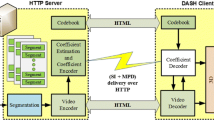Abstract
Tele-immersive 3D communications pose significant challenges in networking research and request for efficient construction of overlay networks, to guarantee the efficient delivery. In the last couple of years various overlay construction methods have been subject to many research projects and studies. However, in most cases, the selection of the overlay nodes is mainly based on network and geographic only criteria. In this book chapter, we focus on the social interaction of the participants and the way that social interaction could be taken into account for the construction of a network multicasting overlay. More precisely, we mine information from the social network structures and correlate it with network characteristics to select the nodes that could potentially serve more than one users, and thus contribute toward the overall network overlay optimization.
Access this chapter
Tax calculation will be finalised at checkout
Purchases are for personal use only
Similar content being viewed by others
References
Papadakis A, Zahariadis T, Mamais G (2013) Advanced content caching schemes and algorithms. Poznan Univ Technol: Adv Electronics Telecommun 3(5):10–16
Yeo CK, Lee BS, Er MH (2004) A survey of application level multicast techniques. Elsevier, Comput Commun 27:1547–1568
Hosseini M, Ahmed D, Shirmohammadi S, Georganas N (2007) A survey of application-layer multicast protocols. IEEE Commun Surv 3rd Quarter 9(3):58–74
Papadakis A, Zahariadis Th, Vrioni C (2014) Monitoring and tailoring the usage of network re-sources for smoothing the provision of interactive 3D services. In: IEEE International Conference on Image Processing (ICIP 2014), Paris, 27–30 Oct
Subramanian L, Stoica I, Balakrishnan H, Katz R (2004) OverQoS: An Overlay Based Archi-tecture for Enhancing Internet QoS, Usenix NSDI, March
Wang G, Zhang B, Eugene Ng TS (2007) Towards network triangle inequality violation aware distributed systems. ACM IMC, San Diego
IETF RFC 6455 (2011) The WebSocket Protocol
Zahariadis T, Papadakis A, Nikolaou Ν (2012) Simulation framework for adaptive overlay content caching. In: 35th IEEE International Conference on Telecommunications and Signal Processing (TSP), Prague, Czech Republic, 3–4 July
Vern Paxson (2004) Strategies for sound internet measurement. In: Proceeding IMC ‘04 Proceedings of the 4th ACM SIGCOMM conference on Internet measurement
Tom Heath (Talis), Christian Bizer (Freie Universität Berlin), Linked Data: Evolving the Web into a Global Data Space. Available at http://linkeddatabook.com/editions/1.0/
Christian Bizer, Tom Heath et al (2008) Linked Data on the Web. In: WWW Conference, Beijing, April
Apache Hadoop Wiki. http://wiki.apache.org/hadoop/
Apache Mahout Wiki. https://cwiki.apache.org/MAHOUT/mahout-wiki.html
Donald Miner, Adam Shook (2012) MapReduce design patterns, building effective algorithms and analytics for Hadoop and other systems. O’Reilly Publishing
FP7/ICT FI-WARE, Future Internet Core Platform, “FI-WARE Data/Context Management”. http://forge.fi-ware.eu/plugins/mediawiki/wiki/fiware/index.php/FI-WARE_Data/Context_Management
Acknowledgments
This work has been partially co-financed by the European Commission through the FP7-ICT-287723 REVERIE project.
Author information
Authors and Affiliations
Corresponding author
Editor information
Editors and Affiliations
Rights and permissions
Copyright information
© 2015 Springer Science+Business Media New York
About this chapter
Cite this chapter
Zahariadis, T., Koufoudakis, I., Lelligou, H.C., Sarakis, L., Karkazis, P. (2015). Utilizing Social Interaction Information for Efficient 3D Immersive Overlay Communications. In: Kondoz, A., Dagiuklas, T. (eds) Novel 3D Media Technologies. Springer, New York, NY. https://doi.org/10.1007/978-1-4939-2026-6_12
Download citation
DOI: https://doi.org/10.1007/978-1-4939-2026-6_12
Published:
Publisher Name: Springer, New York, NY
Print ISBN: 978-1-4939-2025-9
Online ISBN: 978-1-4939-2026-6
eBook Packages: EngineeringEngineering (R0)




